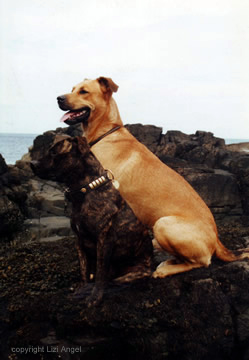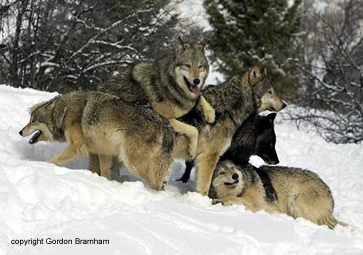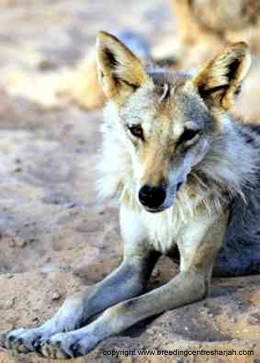|
HOME
ABOUT
A WOLF IN DOG'S CLOTHING?
IS THE
DOG A TRUE PACK ANIMAL?
WHAT DOGS REALLY NEED
THE HUMAN-CANINE BOND
PLAY
STRESS & COMPULSIVE
BEHAVIOUR
KONG STUFFING RECIPES
QUOTES & TESTIMONIALS
BLOG
LINKS
|
| |
There is no doubt that the domestic dog, Canis lupus familiaris,
is descended from the wolf, Canis lupis, but that doesn’t
make the dog a wolf. It’s true that the dog shares the same
number of chromosomes with the wolf, also with the jackal and
the coyote. In fact, all four species can interbreed with one
another and produce offspring.
The dog also shares around 64% of its behavioural
patterns with the wolf, which although is more than any other
two species share, still doesn’t make the dog a wolf ~ after
all, there are 36% of behavioural patterns that remain exclusively
lupine. The brain of the domestic dog is smaller than the wolf
brain. Put simply, the wolf can outsmart the domestic dog any
day because its brain is bigger. A bigger brain means better problem
solving abilities, which is why the wolf, after humans, is the
most widespread of all social predators found throughout Europe,
Asia and North America, with around 38 subspecies of the Grey
wolf (left), also known as the Timber or European wolf, making
up the numbers. |
One of these subspecies, the small Asiatic
wolf (right), also called the Arabian wolf, is the most likely
progenitor of many European and Asian domestic dogs. There are
two possible evolutionary routes of wild, Asiatic wolf to domestic
dog ~ one is artificial selection, the other is natural selection
~ but which route is most likely?
Up until the age of around 33 days, wolf (and dog) puppies are
completely dependent on milk. Wolf biologist Erik Zimen found
that once wolf puppies reached 19 days old, they could not be
socialised to humans. Add to this the fact that even human socialised
wolves are extremely difficult to tame (i.e. to get them to
willingly remain in the company of humans), let alone train,
and that the offspring of a ‘tamed’ wolf, unless
socialised to humans before nineteen days old, will have a lifelong
fear of humans and will flee from their presence, the idea that
the domestic dog evolved through Mesolithic man capturing litters
of pre-19-day-old wild, wolf puppies, managing to keep them
alive until they were able survive on solid food, successfully
raising them to adulthood, keeping them tame, and training them
to be trusty hunting companions, is a very romantic notion.
I suspect that Mesolithic man probably had far more important
things to do.
So artificial selection appears to be the dog’s unlikelier
evolutionary route, however, there is a fantastic example of
modern day, artificial selection that can be used to support
the natural selection theory.
|
|
 |
Although his experiment was with silver
foxes, Russian geneticist, Dmitri Belyaev, managed to produce,
in just 18 generations, foxes that behaved and looked like
dogs. Belyaev hadn’t intended to produce dog-like
foxes. He was actually trying to select for what he observed
in about 10% of the captive bred, but none-the-less wild,
fur farm silver foxes, a quiet, non-fearful, non-aggressive,
exploratory reaction to people, which he and his colleague,
Lyudmila Trut, believed to be inheritable. Belyaev selected
from this population and bred a second generation, which
indeed inherited this calm, curious temperament. His breeding
programme continued but with stricter selection, until only
the foxes that willingly approached him were selected for
breeding. The 18th generation of foxes actively searched
for, climbed on, and took food from their keepers. They
could be carried around, would actively roll over and expose
their bellies, and even responded to their names. They also
had black and white fur, floppy ears and curled tails, made
dog-like sounds, and the females came into heat twice a
year (like wolves, foxes come into heat just once a year).
What Belyaev’s experiment suggests with regards to
the evolution of the domestic dog is that if just a few,
inherently calm and curious individuals from the widespread
Asiatic wolf population chose to remain on the outskirts
of Mesolithic villages and feed off human food waste rather
than by hunting and scavenging elsewhere, and some of the
calmest, most curious of those wolves produced offspring,
through the process of natural selection, the Asiatic wolf
could have evolved into a floppy eared, curly tailed dog-like
creature that whined and barked and willingly followed the
human villagers around. |
Inherently tame, the newly-evolved dog’s strategy
of life differed from that of its wolf forebears. It didn’t
need to stay with its family and hunt in large packs for
the best chance of survival, it just had to co-exist peacefully
and stay near humans, which raises the question, is
the dog a true pack animal?
|
BACK TO TOP |
Copyright
Lizi Angel 2007-2020 |
|
|



